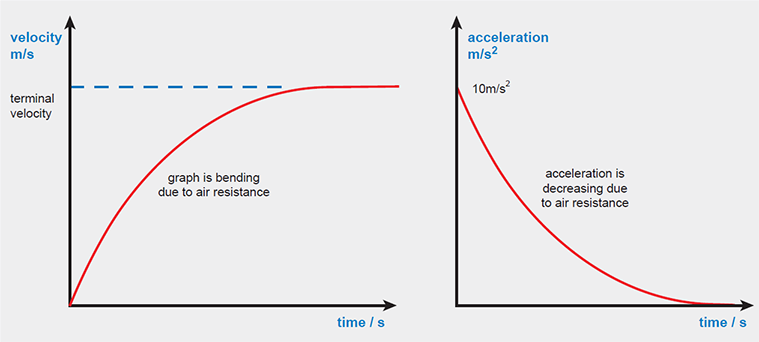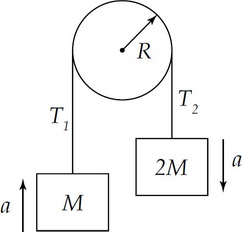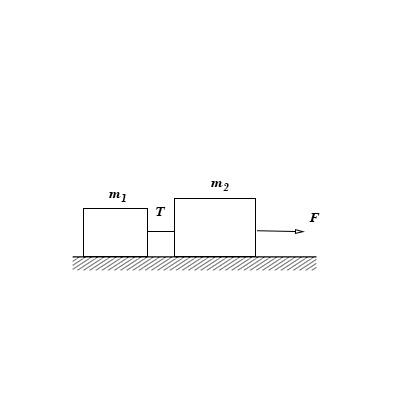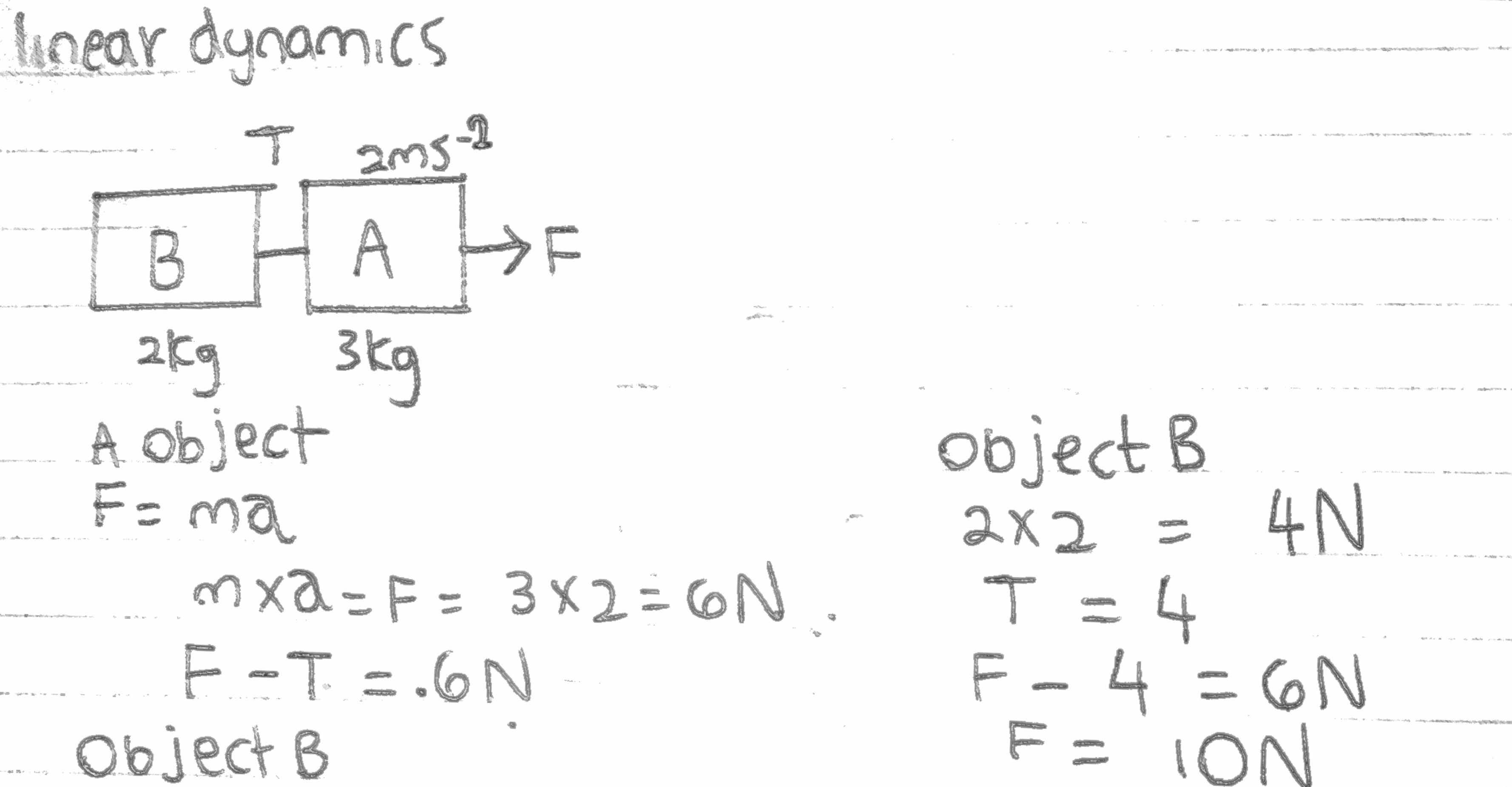Physics AS
Introduction Physical Quantities & Base units Vectors & Scalars Kinematics Pressure & Density Dynamics Momentum Energy, power & efficiency Deformation of solids Waves Superposition Stationary waves Electric fields Electricity Circuits & Kirchoff's laws Radioactive Physics AS PracticalPaper 5More
Reference Pastpaper QuestionsDynamics, Acceleration & Forces
We know what's Motion but, what causes it?
Defining Force
It is the rate of change in momentum
Newton's first law of motion
An object at rest will remain at rest or move at a constant velocity unless acted by a resultant force
By theory, we know that if we don't put a resultant force, an object will move at a constant velocity. So actually no work is done in moving objects, energy is needed when accelerating or changing the momentum of an object.
Newton's second law of motion
A resultant force is directly proportional to the rate of change in momentum in the same direction
Momentum will be discused later
So this means if there is a resultant force acting on an object, it will accelerate and thus change the objects momentum or velocity
Newton's third law of motion
When object A exerts a force on object B then Object B will exert an equal but opposite force on object A
Refer more in the next chapter
Think of a gun! If we fire a gun, we will experience an equal but opposite force
Another example is when we kick a ball we apply a force to the stationary ball and the ball then moves. So it has a change in momentum caused by the resultant force our foot gives. However, you wouldn't realise this, but your leg also stops and this is because there is an equal, but opposite force acting on the leg. The best way to see this is to kick the wall! - the wall moves by a little as it is very large in mass
You will understand this more if you watch this clip from the movie gravity
This law is used to define the law conservation of momentum so remember all of this laws by heart!
Types of Forces
You will need to know the basic understandings of these forces:
Upthrust
This is due to difference in pressures at the top of the object and at the bottom of the object. So they experience different magnitudes of forces. This causes an unbalanced force called upthrust.
So we know the density of a liquid is calculated by:
Pressure = depth * g * density
So due to the height of the object, the bottom part of the object will be more down(greater depth) than the top. So it experiences a greater force or pressure
You will need to remember this equation to calculate upthrust
Upthrust = Pressure at bottom * Area - Pressure at top * Area
Upthrust = A(Pbottom - Ptop)
This is a simplified and more general way of expressing and you don't need to know the below equation but, memorise the above ones:
Upthrust = Volume of object * density of liquid * g
Upthrust = Vgd
The upthrust doesn't usually change as an object sinks as the volume stays the same, in complex situations even density of liquid increases
Things to remember:
- When an object is sinking, then the weight is greater than the upthrust.
- When an object is sinking, the drag increases and so the object reaches terminal velocity.
- When an object is at the bottom, the only forces acting is upthrust and the contact force which equal to the weight.
- Upthrust is always constant and present in an immersed object

Friction
It is the resistive force when two rough layers slide off with each other. They release heat and other formes of energy. It could be reduced by reducing the contact forces between the two surfaces
Viscous/Drag/Air resistances
The resistive force when an object moves through a fluid
So when an object moves faster, the air resistance increase and tries to slow the moving object. This is significant when an object is dropped from a great height
At the start, the only force acting on the object is weight so the ball accelerates at g . So gradient of a velocity-time graph would be g at the start
However, as the object accelerates and speeds up, the air resistance increases which is in the opposite direction and so it reduces the resultant force acting on the object
Resultant = Weight - Air resistance
As it keeps speeding on, the acceleration decreases until the acceleration is zero and then the object moves at a constant velocity called terminal velocity. This is because, the Weight is equal to the Air resistance so there is no resultant force
A Motion graph like the one below tell us that the gradient is slowly decreasing to zero as the acceleration is decreased to zero.
Also remember that when we use a heavier object with the same size. The air resistance acting on the object is the same as it has the same surface area. However, because the heavier object has a greater weight than the lighter one, the air resistance is not significant to slow down the ball by a larger amount. So usually a heavier ball has a larger terminal velocity

How to Determine the acceleration of an object
We know that a resultant force causes an acceleration in an object but, how do we calculate it?
F = ma
So F is the resultant force so we must calculate the resultant force by either vector additions or by adding(if in the same direction) or substracting( if in the opposite direction). We know the mass. so to find a:
F/m = a
So this shows us that when the resulatant force increase, the acceleration is also greater. And greater the mass, lower the acceleration!
In fact for this reason the definition of mass is:
It is a property in an object which resists the change in motion, this is called inertia
So by using F=ma . We could also calculate Weight
Weight = Mass * Acceleration of free fall
W = mg
Weight is the gravitational force acting on an object.
Alternate definition for g is the ratio between weight and mass.
So by looking at this, we can come up with two units (both same base units) for g :
N/kg-1
ms-2
How exam questions confuse you?
Usually they would ask questions such as finding the missing acceleration

So we know that the larger mass will fall down and the lighter mass will rise but, what is the acceleration of the smaller mass
So we use:
F/m =a
Tension of the rope is extended throughout the system
We take up as positive
Fresultant = 2Mg-Mg
Fresultant = Mg
And then we divide the resultant force by the mass of that particular object
a = Fresultant/M
This gives us the acceleration of that specific object only
However, the magnitude of acceleration of both objects are the same but in this question they are in the opposite direction
In some questions, if acceleration of both objects is in the same direction, we can use a simpler equation. As the speed of both objects must be the same and they are in the same direction, both must have the same acceleration.
But always consider the first method as it can be applied for any situation
We can apply this to this question:

In this we can consider the 2 objects as one object
a = F/m
a = F/(m1+m2)
After finding the acceleration, we know the acceleration of each object is the same so the we use F = ma to find the tension
T = m1a
This method only works if the objects are moving in the same direction only. So watch out!
We can use the first method for any type of question even for this, but it becomes a bit complicating as we must use simultaneous equations

F - T = m2a
T = m1a
So we substitue equation 2 in equation 1
F - (m1a) = m2a
F = m2a + m1a
It comes to the same equation as above. This is because, acceleration is constant(in the same direction)
F/m2+m1= a
The force(F) and the masses will be usually given!
This is a simple example:


Recommended
These are things you might like. Clicking these ads can help us improve our free services in the future...
End of Chapter Videos
Collection of Videos to Support Your Understanding.
Remember these videos are handpicked by me and I feel these are the best ones out there. But I constantly update this list for each chapter. The Youtubers are more than welcome to contact me.
Also, don't forget to Subscribe to our Youtube channel - MrWik
Watch
